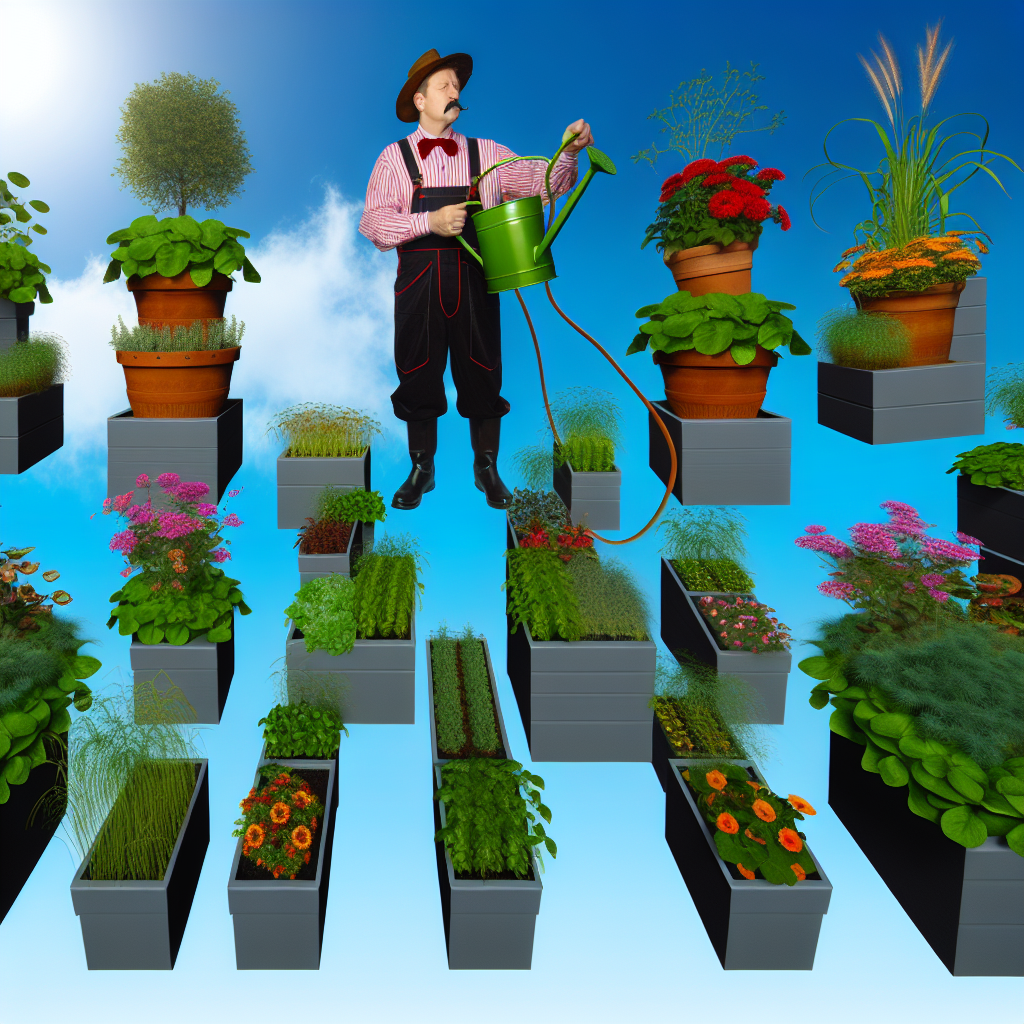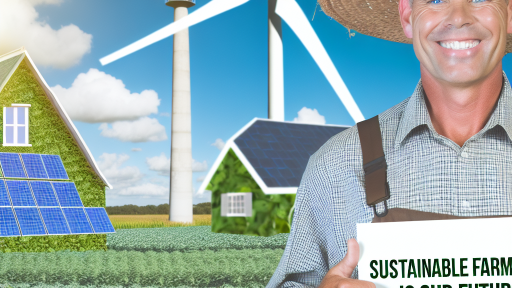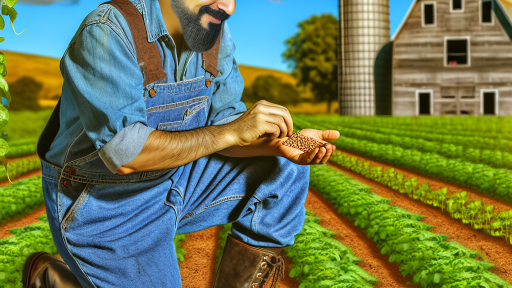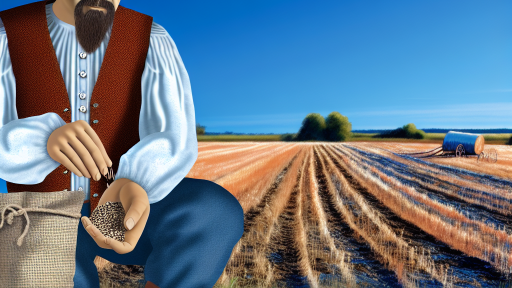Introduction to Container Gardening and Its Benefits for Maximizing Crop Yields
Container gardening has surged in popularity among urban and suburban gardeners.
It offers a flexible approach to growing plants in smaller spaces.
Moreover, gardeners can control various factors more effectively.
Defining Container Gardening
Container gardening involves planting in pots or other containers.
This method allows for easier mobility and arrangement of plants.
Additionally, it creates an opportunity to enhance aesthetics around homes.
Maximizing Space Utilization
One significant advantage of container gardening is efficient space use.
Gardeners can place containers on patios, balconies, or even windowsills.
This method is ideal for individuals with limited outdoor areas.
Improved Soil Quality
Container gardening enables gardeners to utilize high-quality soil mixtures.
This leads to better nutrient retention for plants.
Furthermore, it reduces the risk of soil-borne diseases.
Effective Water Management
Watering becomes more efficient with container gardening.
It allows for precise control over moisture levels in the soil.
Additionally, this reduces water wastage, benefiting both plants and the environment.
Transform Your Agribusiness
Unlock your farm's potential with expert advice tailored to your needs. Get actionable steps that drive real results.
Get StartedEnhanced Pest Control
Container gardening can lead to fewer pest problems.
Gardeners can physically inspect and manage plants easily.
Moreover, using specific potting mixes can deter pests naturally.
Flexibility in Plant Selection
This gardening method offers a wide variety of plant choices.
Gardeners can explore growing unique vegetables, herbs, and flowers.
Container gardening also allows for experimenting with different planting techniques.
Improved Accessibility for All Gardeners
Container gardening is particularly beneficial for those with mobility issues.
Plants can be placed at varying heights for easier accessibility.
This approach ensures that everyone can enjoy gardening regardless of physical ability.
Year-Round Gardening Opportunities
Container gardening can extend the growing season significantly.
Gardeners can move containers indoors during colder months.
By managing indoor light and temperature, fresh produce can be enjoyed year-round.
Choosing the Right Containers
Size Considerations
Choosing the right size container is crucial for plant growth.
A container that is too small restricts root development.
Conversely, a container that is too large may retain excess moisture.
Consider the mature size of the plant when making your selection.
A general rule is to select a container that is at least twice the width of the plant’s root ball.
This ensures adequate space for growth and stability.
Material Options
The material of a container affects plant health and growth.
Common materials include plastic, ceramic, and metal.
Plastic containers are lightweight and affordable.
Ceramic containers add aesthetic appeal but can be heavy.
Metal containers often heat up quickly, which can affect root health.
Choose materials that provide the right balance of durability and insulation.
Showcase Your Farming Business
Publish your professional farming services profile on our blog for a one-time fee of $200 and reach a dedicated audience of farmers and agribusiness owners.
Publish Your ProfileDrainage Considerations
Proper drainage is essential for container gardening.
Excess moisture can lead to root rot and plant diseases.
Ensure containers have drainage holes at the bottom.
Consider adding a layer of gravel or stones to improve drainage.
This layer can prevent soil from clogging the drainage holes.
Regularly check soil moisture to avoid overwatering.
Additional Factors
Lastly, consider the environmental conditions of your growing area.
Some materials may retain heat differently than others.
Furthermore, lightweight containers are easier to move in different weather conditions.
Selecting the right container can ultimately lead to healthier plants and higher yields.
Soil Selection and Preparation for Optimal Growth in Container Gardens
Importance of Soil Quality
Soil quality directly impacts plant growth and yields.
Healthy soil provides essential nutrients.
Additionally, it supports proper drainage and aeration.
Choosing the right soil mix enhances plant health.
Components of a Quality Soil Mix
A well-balanced soil mix consists of various components.
- Organic matter improves soil structure.
- Coco coir offers excellent moisture retention.
- Perlite ensures good drainage and aeration.
It is also beneficial to include compost for nutrients.
Selecting the Right Container
Container choice impacts the soil’s effectiveness.
Ensure your container has adequate drainage holes.
This aids in preventing waterlogging.
Also, select a container size suitable for the plant type.
Preparing the Soil
Start by mixing your soil components uniformly.
Incorporate organic fertilizers for a nutrient boost.
Adjust pH levels based on your plants’ needs.
Testing soil pH helps achieve optimal growth conditions.
Maintaining Soil Health
Regular monitoring of soil conditions is essential.
Adding mulch conserves moisture and suppresses weeds.
Rotate crops to prevent nutrient depletion.
Additionally, amend the soil annually with compost.
You Might Also Like: DIY Mushroom Growing Kits for Small-Scale Farmers
Selecting Crop Varieties Suitable for Container Growth
Understanding Container Gardening
Container gardening allows you to efficiently grow plants in limited spaces.
It is suitable for urban settings and small backyards.
Additionally, it provides flexibility in plant selection.
Choosing the Right Crops
Start by considering your available space.
Different crops have varying space requirements.
Choose compact or dwarf varieties for success.
Vegetables for Container Gardening
Many vegetables thrive in containers.
- Tomatoes are a popular choice.
- They require at least 5 gallons of soil.
- Peppers also perform well in pots.
- Look for smaller varieties like chili peppers.
- Lettuce and herbs grow easily in containers.
Flowers That Flourish
Consider growing flowers in containers as well.
Petunias and marigolds add beauty and color.
Also, consider compact annuals for shorter growing seasons.
Factors to Consider
Select crops based on your climate and season.
Showcase Your Farming Business
Publish your professional farming services profile on our blog for a one-time fee of $200 and reach a dedicated audience of farmers and agribusiness owners.
Publish Your ProfileSome plants, like basil, thrive in warm weather.
Others, such as spinach, prefer cooler temperatures.
Match plant types with your local growing conditions.
Experimentation is Key
Don’t hesitate to try new varieties.
Container gardening is a perfect opportunity to experiment.
Keep notes on which crops perform best in your setup.
This practice helps in maximizing yield over time.
See Related Content: Climate Control Strategies for Mushroom Cultivation
Watering Techniques: Frequency and Methods to Enhance Crop Yield
Importance of Watering in Container Gardening
Watering is essential for plant growth and development.
In container gardening, effective watering can greatly influence crop yields.
Moreover, consistent watering practices promote plant health and vigor.
Understanding Watering Frequency
Different plants have varying water requirements.
Generally, container plants need more frequent watering than those in the ground.
Monitor the moisture level of the soil regularly.
As a rule of thumb, water when the top inch of soil feels dry.
However, be cautious not to overwater.
Methods for Efficient Watering
Choose watering methods that suit your gardening style and crop types.
Hand watering provides precision and control over your plants’ moisture.
Furthermore, drip irrigation delivers water directly to the roots.
This method minimizes evaporation and promotes water efficiency.
Using self-watering containers can also provide a steady moisture supply.
Best Practices for Watering
Avoid watering during the hottest part of the day.
Morning is the ideal time for watering as it reduces evaporation losses.
Additionally, use room-temperature water to avoid shocking the plants.
When watering, apply enough water so it drains from the bottom.
This ensures deep root penetration and prevents shallow root systems.
Utilizing Mulching for Moisture Retention
Mulching helps retain soil moisture and reduces evaporation rates.
Organic materials like straw or wood chips work best for mulching.
Furthermore, a layer of mulch can suppress weeds and regulate soil temperature.
Adapting to Seasonal Changes
Adjust your watering schedule according to seasonal changes.
During hot summer months, plants may require more frequent watering.
Conversely, reduce watering during cooler or rainy periods.
Always observe your plants for signs of stress or overwatering.
Learn More: Container Gardening For Urban Farming Success
Nutrient Management: Organic Fertilizers and Soil Amendments for Container Plants
Understanding Nutrient Requirements
Container plants often require more attention than traditional garden plants.
They depend heavily on the nutrients found in the soil mix.
As a result, regular monitoring is essential for optimal growth.
Plants absorb nutrients differently based on their stage of growth.
Understanding these differences can help enhance crop yields.
Choosing Organic Fertilizers
Organic fertilizers provide essential nutrients without harmful chemicals.
Showcase Your Farming Business
Publish your professional farming services profile on our blog for a one-time fee of $200 and reach a dedicated audience of farmers and agribusiness owners.
Publish Your ProfileThey improve soil structure and promote beneficial microbial activity.
Common options include compost, worm castings, and bone meal.
These materials slowly release nutrients, ensuring steady plant growth.
Additionally, they help maintain moisture levels in the soil.
Types of Organic Fertilizers
- Compost enriches the soil and adds microbial life.
- Bone meal provides a rich source of phosphorus.
- Fish emulsion offers a quick nutrient boost.
- Seaweed extracts supply trace minerals and growth hormones.
Implementing Soil Amendments
Soil amendments adjust the texture and nutrient content of potting mixes.
They can enhance drainage, aeration, and water retention.
Regularly incorporating amendments can lead to healthier plants.
Popular Soil Amendments
- Pearlite improves drainage in dense soils.
- Vermiculite retains moisture and nutrients.
- Coconut coir is an eco-friendly alternative to peat moss.
Application Techniques
Applying organic fertilizers and soil amendments requires careful attention.
Start with a soil test to determine existing nutrient levels.
Then, follow recommended application rates for each product.
Additionally, consider top-dressing containers every few weeks.
This boosts nutrient levels during the growing season.
Monitoring and Adjusting
Monitoring plant health is crucial for effective nutrient management.
Look for signs like yellowing leaves or stunted growth.
These symptoms often indicate nutrient deficiencies.
Adjust your fertilization schedule based on planting needs.
Moreover, conducting soil tests periodically can provide valuable insights.
You Might Also Like: Understanding Seed Germination For Farmers

Pest and Disease Management in Container Gardening
Understanding Common Pests
Container gardening invites various pests into your garden.
Common pests include aphids, spider mites, and whiteflies.
It is essential to identify these pests early on.
Look for signs like leaves turning yellow or wilting.
Additionally, inspect the undersides of leaves for eggs or larvae.
Implementing Preventive Measures
Preventing pests is more effective than reacting to them.
Start by choosing healthy seedlings from reputable sources.
Next, maintain cleanliness in your gardening area.
Remove any dead plant material and debris regularly.
Furthermore, rotating plants in containers can disrupt pest life cycles.
Natural Pest Control Methods
Consider using natural solutions to combat pests.
Insects like ladybugs are excellent for controlling aphids.
Introduce predatory insects or neem oil as a repellent.
Additionally, insecticidal soap can effectively eliminate soft-bodied pests.
Always test these solutions on a small plant area first.
Disease Management Strategies
Diseases can spread quickly in container gardens.
Common diseases include powdery mildew and root rot.
Moreover, ensure proper air circulation around your plants.
Water plants at soil level to minimize leaf wetness.
Remove and dispose of affected plants promptly to prevent spread.
Identifying Plant Diseases
Recognizing symptoms can save your container garden.
Look for unusual spots, wilting, or discolored leaves.
Showcase Your Farming Business
Publish your professional farming services profile on our blog for a one-time fee of $200 and reach a dedicated audience of farmers and agribusiness owners.
Publish Your ProfileThese signs may indicate fungal, bacterial, or viral infections.
Using disease-resistant plant varieties can reduce risks.
Consult with gardening experts if uncertain about a diagnosis.
Using Proper Tools and Techniques
Effective disease management requires the right tools.
Always use clean, sterilized gardening tools.
Regularly inspect and maintain your watering equipment.
Furthermore, consider using biodegradable pots to reduce root diseases.
Finally, follow the recommended guidelines for each plant type.
Seasonal Considerations: Planting, Harvesting, and Crop Rotation in Containers
Optimal Planting Times
Understanding the best planting times enhances your crop yield.
Begin with an early spring planting for cool-season crops.
Examples include lettuce, spinach, and radishes.
Next, plant warm-season crops after the threat of frost has passed.
Consider tomatoes, peppers, and zucchini for your summer garden.
Research your local climate zone to ensure proper timing.
Harvesting Strategies
Developing effective harvesting strategies maximizes productivity.
Regularly check plants for maturity to avoid overripening.
Use a sharp knife or scissors to cut crops cleanly.
Harvest in the morning when temperatures are cooler.
This practice enhances flavor and freshness.
Store harvested produce immediately to maintain quality.
Implementing Crop Rotation
Crop rotation prevents soil depletion and pest buildup.
Group plants by their nutrient needs for effective rotation.
Example groupings include leafy greens, root vegetables, and legumes.
Rotate crops annually to disrupt pest and disease cycles.
Record your planting history for effective planning next season.
Seasonal Adjustments
Adapting to seasonal changes is crucial for success.
Be mindful of temperature fluctuations that may affect growth.
Use protective covers during unexpected cold snaps.
In summer, provide shade to prevent heat stress on plants.
Regularly monitor water levels during dry spells.
Adjust your watering schedule based on seasonal rainfall.
Container-Specific Considerations
Container gardening requires unique strategies for planting and care.
Ensure containers have adequate drainage to prevent overwatering.
Choose the right soil mix to provide necessary nutrients.
Consider the size of the container for each plant type.
Keep in mind the sun requirements when arranging containers.
Observe how plants grow in specific locations for future adjustments.
Innovative Growing Techniques: Vertical Gardening and Hydroponics in Containers
Exploring Vertical Gardening
Vertical gardening utilizes vertical space to maximize crop yields.
It allows gardeners to grow plants upwards rather than outwards.
This method is ideal for small spaces or urban environments.
Showcase Your Farming Business
Publish your professional farming services profile on our blog for a one-time fee of $200 and reach a dedicated audience of farmers and agribusiness owners.
Publish Your ProfileAdditionally, it promotes healthier plants by improving air circulation.
Furthermore, vertical systems can reduce pest infestations.
Some popular structures include trellises, wall planters, and living walls.
Herbs, strawberries, and pole beans thrive in vertical gardens.
Consider using recycled materials like pallets or plastic bottles.
Vertical gardening enhances aesthetic appeal while being functional.
Benefits of Hydroponics
Hydroponics refers to growing plants without soil.
This method uses nutrient-rich water to nourish plants directly.
It allows for precise control over nutrient delivery and water usage.
Consequently, hydroponic systems often yield faster growth rates.
Plants require less space, making it suitable for containers.
Common hydroponic techniques include nutrient film technique and deep water culture.
These systems can be set up indoors or outdoors, offering flexibility.
Moreover, hydroponics reduces the risk of soil-borne diseases.
Some popular crops for hydroponics include lettuce, tomatoes, and basil.
Combining Techniques for Maximum Yield
Combining vertical gardening with hydroponics can optimize production.
This hybrid approach utilizes minimal space for maximum output.
It allows you to grow a variety of crops in a compact area.
Furthermore, it provides an opportunity to experiment with different plants.
Utilize vertical hydroponic systems to enhance your gardening practices.
Invest in a quality pump and reserve tank for hydroponic systems.
Ensure plants have adequate access to light for optimal growth.
Experimenting with different nutrient solutions can yield various results.
Tracking plant growth and yield can help optimize your methods further.
Best Practices for Sustaining High Crop Yields in Container Gardening
Choosing the Right Containers
Select containers that offer good drainage.
Terracotta, plastic, and wood are popular choices.
Make sure to choose the right size for your plants.
Deep-rooted plants require larger containers.
Consider the weight of the container when full.
Soil Preparation and Quality
Use high-quality potting soil specifically designed for container gardening.
Add organic matter to improve soil fertility.
Include slow-release fertilizers to nourish the plants over time.
Maintain soil moisture levels for optimal plant growth.
Optimal Plant Selection
Select plants that thrive in confined spaces.
Compact varieties of vegetables are often best.
Herbs also grow well in container gardens.
Choose plants suited to your climate and season.
Watering Techniques
Water consistently to prevent drought stress.
Check soil moisture levels regularly for best results.
Consider using self-watering containers for efficiency.
Showcase Your Farming Business
Publish your professional farming services profile on our blog for a one-time fee of $200 and reach a dedicated audience of farmers and agribusiness owners.
Publish Your ProfileDrip irrigation systems can also optimize water use.
Sunlight Management
Position containers to receive adequate sunlight.
Most vegetables need at least six hours of sun a day.
Use reflective materials to increase light exposure if needed.
Monitor plant health to adjust sunlight exposure as necessary.
Pest and Disease Control
Regularly inspect plants for signs of pests and diseases.
Utilize organic pest control methods whenever possible.
Encourage beneficial insects to manage pest populations.
Maintain cleanliness around the containers to prevent disease.
Seasonal Care Practices
Rotate plants seasonally to maintain soil health.
Consider crop rotation to avoid nutrient depletion.
Protect plants from extreme weather conditions when necessary.
Mulching can help retain moisture and suppress weeds.
Additional Resources
Anu awarded $175K USDA SBIR grant to advance Pure Produce …
What Is Commercial Agriculture? | Pure Greens Container Farms




